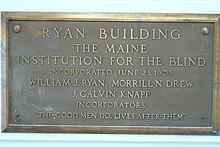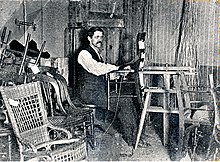The Iris Network
The Iris Network is a private non-profit agency located in Portland, Maine.[1] The agency provides vision rehabilitation and other services to blind and visually impaired adults so that they may live as fully and independently as possible.[2] Its professional services are accredited by the National Accreditation Council of the Association for Education and Rehabilitation of the Blind and Visually Impaired.[3]
 Iris Network main entrance sign | |
| Formation | June 23, 1905 |
|---|---|
| Purpose | Vision Rehabilitation |
| Location |
|
President | David Barnwell |
| Website | www |
Formerly called | The Maine Center for the Blind |
Formerly known as the Maine Center for the Blind and Visually Impaired, the agency was originally incorporated as the Maine Institution for the Blind in June 1905 with support from deaf-blind activist Helen Keller.[4] Maine Civil War General and Governor Joshua Chamberlain assisted with its founding and served on its first Board of Directors.[5] Other recent Advisory Board members include former US Senate Majority Leader and US Special Envoy for Middle East Peace George Mitchell and former NFL Commissioner Paul Tagliabue.[6]
The agency opened for services in October, 1909, and has been in continuous operation since that time. Located in the Parkside neighborhood of Portland, the campus features two historic early 20th-century brick buildings and includes administrative offices, a residential Rehabilitation Center, a Low Vision Center, and private residential apartments specifically designed to be accessible to the blind. The agency was renamed the Iris Network in 2000.[2]
Early history
The founding of the organization was largely due to the efforts of Portland native William J. Ryan (1864-1936). Mr. Ryan was visually impaired and had a small business caning chairs in the Portland City Hall building on Myrtle Street. For four months of the year, Mr. Ryan traveled throughout Maine selling the Old Farmer's Almanac. In his travels, he encountered many blind and visually impaired individuals who either lived at home or who were dependent upon the charity of others. Mr. Ryan believed that it was every individual’s right to earn his own living, and he took every opportunity to promote the need for a facility that would teach a trade to individuals who were blind or visually impaired.[7]

In February 1905, Mr. Ryan reached out to Helen Keller asking her to come to Maine to assist in the effort. She wrote back, “Although I cannot come to Maine, this cause is dear to my heart. Opportunity to work is what we ask for the blind, not charity. To get the most out of life, we must work. In work, mankind has his highest dignity and his highest happiness.”[8] Although she was unable to attend in person, Miss Keller organized a fundraiser which raised over $1,000 for the organization in 1907.[9]
The Maine Institution for the Blind officially opened for business on October 18, 1909 in a newly constructed factory on Park Avenue in Portland, which also housed the men who worked in the building. The factory was equipped for manufacturing corn brooms, chair caning and mattress making. These departments were supervised by foremen who were blind or visually impaired.[5] By 1936, the agency employed 29 individuals, all of whom lived at the agency and worked in the various departments. Men and women were kept separate both at work and in their dorms.[9]
William J. Ryan continued to work caning chairs in the factory, and became the agency’s first “Special Agent”, reaching out to blind individuals throughout Maine on his annual almanac-selling trips. The factory building was renamed for Mr. Ryan after his death in 1936.[7]

The second structure on the campus was built for $12,000 and was funded by the efforts of the Gorham Dames and the generosity of Mrs. Virginia Jordan in memory of her mother, sister and brother. Known as the Barker House, it was used as an administrative building and women’s dormitory.[5] A small brick bungalow was built in 1919 as a residence for the superintendent of the agency. This building was demolished when the lot upon which it sat was sold in 1986.[9]
In 1920, with an appropriation of $35,000 from the Maine Legislature and contributions of an equal amount from friends, a men’s residence was purchased at Deering and Park Avenues. This was sold in 1942 to the City of Portland and is now the site of the King Middle School.[4]
Community rehabilitation services
In 1974, the Maine Institution for the Blind applied for and received block grant funding through the Social Security Act Title XX for creating a community-based rehabilitation program in Southern Maine.[9] Known as the Field Program, it was designed to teach adaptive daily living skills to visually impaired individuals in their homes, schools and workplaces. Initially, 4 rehab teachers were hired by MIB, and one more was placed with the Maine Department of Labor’s Division for the Blind & Visually Impaired (DBVI).[10]
In 1978-79, the Field Program moved to Catholic Charities Maine, then known as Diocesan Human Relations Services, due to cash-flow problems at MIB. The agency’s financial situation stabilized under the leadership of Director Robert Crouse.[11] The program returned to MIB in 1980 and was re-named Community Services.
Throughout the 1980’s, the Community Services Program expanded to cover 15 of the 16 counties in the State of Maine. The program began serving Maine’s northernmost region, Aroostook County, in 1992. Over time, the teaching staff became professionally-certified Vision Rehabilitation Therapists, many of whom hold a master’s degree in Education.[12] [13]
In 2016, the Community Services contract was temporarily awarded to Catholic Charities Maine by the Maine Department of Labor (DOL).[14] The Iris Network appealed the decision to the state Department of Administrative and Financial Services, claiming that “several unlawful and fundamentally unfair errors” were made by the DOL in selecting Catholic Charities, and that the bid from The Iris Network was more than $200,000 lower.[15] The appeal was a success, and the contract was awarded to the Iris Network in 2017.[16]
Today, the agency employs 11 Certified Vision Rehabilitation Therapists who work throughout the State of Maine, and it continues to partner with DBVI and the Department of Labor to fund this program.[17]
Assistive technology and job services
By the late 1960s, decreased demand for broom making and chair caning led to the closure of the factory. After a brief foray into textile manufacturing in the 1970s, the agency, now known as the Maine Center for the Blind and Visually Impaired, decided instead to focus its training programs on the assistive technology (AT) skills needed in the modern information-based workplace.[18]
Today, the Iris Network offers customized individual or class instruction in AT to adults with vision loss who are looking to find employment or to expand existing career skills. The program assists its clients with placement and support services and also serves as a resource for businesses interested in hiring or retaining employees with visual impairment by helping them make workplace accommodations.[4] Beginning in 2019, the Iris Network partnered with Maine Medical Center to provide job coaching services to visually impaired adults in the southern Maine region.[19]
Residential rehabilitation center
Between 1979 and 1991, the agency operated a residential rehabilitation center to teach adaptive daily living skills to people who were either newly blind or had experienced a gradual loss of vision.[9]
The Iris Network Rehabilitation Center re-opened in 2015 following a complete renovation of the interior of the Ryan Building that was funded by a grant from the Rehabilitation Services Administration. The facility features an Assistive Technology Center, a Braille classroom, a manual arts workshop, and a model training apartment with full kitchen. The program was designed to focus on teaching pre-vocational and life skills to adult students from Maine and across the United States.[20] Students from New Hampshire, New York, and Connecticut have undergone training at the center.[21]
Low vision center
On May 5, 2005, the agency opened its doors to a weekly Low Vision Clinic under the leadership of its Medical Director, ophthalmologist A. Jan Berlin.[22] Dr. Berlin, a 1960 graduate of Case Western Reserve University School of Medicine,[23] purchased $50,000 worth of equipment for only $15,000 after learning that a low vision clinic was closing on Long Island, New York. Working in tandem with an occupational therapist, eye doctors with a specialization in low vision assisted patients in understanding their eye condition and making the most of their remaining usable vision. The clinic went on hiatus in the fall of 2019. The Low Vision Center continues to assist clients with trialing and purchasing low vision aids and other assistive technology.[24]
Iris Park Apartments

Also in 2005, ground was broken for a major new addition to the Barker Building. The Iris Park Apartments (IPA) opened in 2006 and features 30 units of low-income housing and community space specifically designed for people who are visually impaired or blind. IPA houses a level-one assisted living facility, with oversight provided by a resident services administrator.[4] A recreation program offers residents varied opportunities including adaptive sports such as sailing, skiing, and rock climbing in partnership with the Horizons program of the Adaptive Outdoor Education Center, and musical offerings for interested participants.[25][26][27]
Outreach and advocacy
The Iris Network White Cane Walk for Independence takes place annually on the second Saturday of October.[28] The event is designed to promote a better understanding of Maine’s White Cane Law, which was signed into law by Governor Angus S. King in 1999,[29] and to increase public awareness of safe independent travel for people who use white canes or guide dogs.[30]
References
- https://www.pressherald.com/interactive/maine_tax_exempt_organizations_irs_non-profits/
- https://www.guidestar.org/profile/01-0196359/
- https://aerbvi.org/the-national-accreditation-council/
- Platt, John (March 2018). "The Iris Network: Maine's Lifeline for the Visually Impaired". Lion. Retrieved May 26, 2020.
- Chamber of Commerce Journal of Maine. 1909. pp. 290–.
- https://www.theiris.org/about-us/advisory-board/
- Barker, Matt (2017-07-19). "The Maine Institution for the Blind". Maine. Retrieved May 26, 2020.
- https://www.youtube.com/watch?v=es8ZdP4NAgg
- https://www.theiris.org/uploads/pdf/100th%20anniversary%20booklet.pdf
- Vittorioso, Laura. "Marj Awalt, a Pioneer in the Vision Rehabilitation Field". Retrieved May 26, 2020.
- Hoey, Dennis (2011-04-12). "Feature obituary: Robert Crouse, 71, innovative champion of the blind". Portland Press Herald. Portland, Maine. Retrieved May 26, 2020.
- "Trio of Iris Network employees earn national awards". The Forecaster. Falmouth, Maine. 2018-08-22. Retrieved May 25, 2020.
- Roberts, Peggy (2006-04-27). "Sights set high". Lakes Region Weekly. Windham, Maine. Retrieved May 26, 2020.
- Harry, David (2016-06-22). "Iris Network contests award of state bid". The Forecaster. Falmouth, Maine. Retrieved May 26, 2020.
- Harry, David (2016-08-30). "Maine panel hears Iris Network appeal on lost contract". The Forecaster. Falmouth, Maine. Retrieved May 26, 2020.
- "Iris Network in Portland wins DOL contract for services". The Forecaster. Falmouth, Maine. 2017-07-17. Retrieved May 26, 2020.
- https://visionaware.org/directory/profile/the-iris-network/
- Stoltzberg, Jessica (1992). "Maine Center for the Blind". Salt. Retrieved May 26, 2020.
- https://mainehealth.org/maine-medical-center/community/vocational-services/
- Harry, David (2016-04-26). "Iris Network program in Portland trains visually impaired for life, work". The Forecaster. Falmouth, Maine. Retrieved May 25, 2020.
- "Simsbury Woman Completes Iris Network Rehabilitation Center Program in Portland Maine". Hartford Courant. Hartford, Connecticut. 2016-10-30. Retrieved May 26, 2020.
- Nemitz, Bill (2017-11-25). "Clinic a ray of hope for those with failing sight". Portland Press Herald. Portland, Maine. Retrieved May 26, 2020.
- https://www.healthcare4ppl.com/physician/maine/portland/a-jan-berlin-1760414734.html/
- "People & Business: Dec. 7". The Forecaster. Falmouth, Maine. 2016-12-06. Retrieved May 26, 2020.
- https://www.adaptiveoutdooreducationcenter.org/programs/
- http://www.317main.org/the-iris-network/
- http://maineoutdoorfilmfestival.com/films/aaron-sailmaine/
- "Taking steps to raise awareness". Portland Press Herald. Portland, Maine. 2010-10-17. Retrieved May 26, 2020.
- https://legislature.maine.gov/statutes/17/title17sec1313.html/
- "Taking a walk on the blind side in Portland". The Forecaster. Falmouth, Maine. 2015-10-19. Retrieved May 26, 2020.